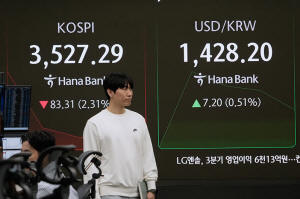Asian shares skid after Wall Street tumbles to its worst day since April
as China trade woes worsen
[October 13, 2025] By
ELAINE KURTENBACH
BANGKOK (AP) — Asian shares tumbled on Monday as escalating trade
tensions with China shattered a monthslong calm on Wall Street.
U.S. stocks skidded on Friday after President Donald Trump threatened to
crank tariffs higher on China, signaling more trouble ahead between the
two biggest economies. He was responding to restrictions Beijing is
imposing on exports of rare earths, which are materials that are
critical for the manufacturing of everything from consumer electronics
to jet engines.
But U.S. futures advanced, with the contract for the S&P 500 gaining
1.4% while that for the Dow Jones Industrial Average gained 1%.
China reported its global exports rose 8.3% in September from a year
earlier, the strongest growth in six months and further evidence that
its manufacturers are shifting sales from the U.S. to other markets.
Exports to the U.S. tumbled 27% year-on-year last month, customs data
showed.
In Hong Kong, the Hang Seng sank 2.2% to 25,700.07.
Most other major regional markets logged losses of more than 1%.
The Shanghai Composite index edged 0.2% lower to 3,889.50 and the Kospi
in South Korea gave up 0.7% to 3,584.55.
Australia’s S&P/ASX 200 declined 0.8% to 8,882.80. Taiwan's Taiex shed
1.4% and India's Sensex was down 0.4%.
Markets in Tokyo were closed for a holiday.
On Friday, the S&P 500 sank 2.7% in its worst day since April, closing
at 6,552.51. The Dow Jones Industrial Average dropped 1.9% to 45,479.60,
and the Nasdaq composite lost 3.6% to 22,204.43.

The setback reflected signs of a re-escalation of the trade war.
“We have been contacted by other Countries who are extremely angry at
this great Trade hostility, which came out of nowhere,” Trump wrote on
Truth Social, alluding to Beijing. He also said “now there seems to be
no reason” to meet with China’s leader, Xi Jinping, after earlier
agreeing to do so as part of an upcoming trip to South Korea.
Roughly six out of every seven stocks within the S&P 500 fell. Nearly
everything weakened, from Big Tech companies like Nvidia and Apple to
stocks of smaller companies looking to get past uncertainty about
tariffs and trade.
[to top of second column] |

A currency trader passes by a screen showing the Korea Composite
Stock Price Index (KOSPI), top left, and the foreign exchange rate
between U.S. dollar and South Korean won at the foreign exchange
dealing room of the Hana Bank headquarters in Seoul, South Korea,
Monday, Oct. 13, 2025. (AP Photo/Ahn Young-joon)
 The market may have been primed for
a slide. U.S. stocks were already facing criticism that their prices
had shot too high following the S&P 500’s nearly relentless 35% run
from a low in April. The index, which dictates the movements for
many 401(k) accounts, is still near its all-time high set earlier in
the week.
Critics say the market looks too expensive after prices rose much
faster than corporate profits. Worries are particularly high about
companies in the artificial-intelligence industry, where pessimists
see echoes of the 2000 dot-com bubble that imploded. For stocks to
look less expensive, either their prices need to fall, or companies’
profits need to rise.
In the bond market, the yield on the 10-year Treasury sank to 4.05%
from 4.14% late Thursday.
It had already been lower before Trump made his threats, as a report
from the University of Michigan suggested that sentiment among U.S.
consumers remains in the doldrums.
Some of Friday’s strongest action was in the oil market, where the
price of a barrel of benchmark U.S. crude sank 4.2% to $58.90.
It fell as a ceasefire between Israel and Hamas came into effect in
Gaza. An end to the war could remove worries about disruptions to
oil supplies, which had kept crude’s price higher than it otherwise
would have been.
Losses accelerated following Trump’s tariff threat, which could gum
up global trade and lead the economy to burn less fuel.
Brent crude, the international standard, dropped 3.8% to $62.73 per
barrel. However, early Monday it was trading 85 cents higher at
$63.58 per barrel. U.S. benchmark crude oil gained 72 cents to
$59.62 per barrel.
In other dealings early Monday, the dollar rose 152.22 Japanese yen
from 151.89 yen late Friday. The euro fell to $1.1605 from $1.1614.
All contents © copyright 2025 Associated Press. All rights reserved |